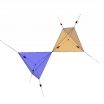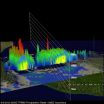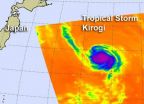(Press-News.org) How strong can earthquakes in Germany be? Where in Europa are the earthquake activities concentrated? These questions are the basis for risk assessments and become relevant when it comes to the safety of buildings or the generation of tsunami.For the first time, scientists of the GFZ German Research Centre for Geosciences have succeeded in setting up a harmonized catalogue of earthquakes for Europe and the Mediterranean for the last thousand years. This catalogue consists of about 45000 earthquakes, reported in the latest issue of the „Journal of Seismology".
Earthquakes occur with different frequencies of occurrence, meaning that in some regions, strong earthquakes happen with time gaps of hundreds of years. Such rare events can cause a false feeling of security which belies the true risk. This is compounded by the fact that instrumental measurements only go back for roughly a century, and reliable data for smaller quakes for about half that long.
Thus, the only way to assess the actual risk is the analysis of historical earthquake accounts. „The catalogue that we present here covers the earthquakes of the last thousand years with magnitudes of Mw 3,5 and larger in the northern part of our research area and magnitudes Mw4,0 for the southern part", explains Dr. Gottfried Grünthal of the GFZ. „Our earthquake catalogue stretches over an area from the Azores to the Caspian Sea and from the Sahara to the North Cape." Based on some 80 mostly national earthquake catalogues, more than 100 other sources and own analyses of key historical earthquakes, the EMEC-catalogue (European-Mediterranean Earthquake Catalogue) offers the first reliable, regional, long-time database with a harmonized assessment of earthquake magnitudes.
In bringing together all these sources with their considerable differences in magnitude or intensity scales, particular care was taken to harmonize the latter in the form of moment magnitude Mw. The earthquakes in the EMEC are catalogued from 1000 AD bis 2006. In areas south of 40°N and east of 10°E the available data allow for an analysis starting from 300 AD. Of course these data are not complete, especially in the early phase of the catalogued time period.The point in time after which data for certain magnitudes can be assumed as sufficiently complete is very different within the research area. For example, earthquakes with a magnitude of Mw 6,5 and above in the Levant exist more or less completely since 300 AD, and earthquakes of Mw 5 and above since 1965. In Germany, the catalogue of earthquakes with Mw 5 and greater is sufficiently complete since about 1600.
„Part of the EMEC-publication is also a list of so-called fake-quakes, i.e. quakes that have been reported erroneously due to errors of the chroniclers, errors in dates or other mistakes", explains GFZ scientist Gottfried Grünthal. Importance was also attached to a user-friendly web page: „On the GFZ-EMEC-website, data can be downloaded according to the wishes of the users and epicentre maps can be generated, stored and printed in customized scales of time and space and map projections."
The EMEC catalogue provides a reliable basis for the risk assessment of earthquakes and quake generated tsunami. Moreover, it is a solid foundation for a whole range of other geoscientific research as well as a source for investigations outside of science.
###Pictures in a printable resolution can be found here:
www.gfz-potsdam.de/portal/gfz/Public+Relations/M40-Bildarchiv/Bildergalerie+EMEC
www.gfz-potsdam.de/EMEC
Source: Grünthal G., Wahlström R. (2012) The European-Mediterranean Earthquake Catalogue (EMEC) for the last millennium. Journal of Seismology 16(3): 535-570, DOI: 10.1007/s10950-012-9302-y
The earthquake risk and Europe
Harmonized Earthquake Catalogue for Europe and the Mediterranean for the last millennium available for the first time
2012-08-10
ELSE PRESS RELEASES FROM THIS DATE:
Researchers combine remote sensing technologies for highly detailed look at coastal change
2012-08-10
Athens, Ga. – Shifting sands and tides make it difficult to measure accurately the amount of beach that's available for recreation, development and conservation, but a team of University of Georgia researchers has combined several remote sensing technologies with historical data to create coastal maps with an unsurpassed level of accuracy.
In a study published in the August issue of the journal Tourism Management, they apply their technique to Georgia's Jekyll Island and unveil a new website that allows developers, conservationists and tourists access to maps and data ...
Hepatitis A vaccination in children under 2 remains effective for 10 years
2012-08-10
Vaccination against the hepatitis A virus (HAV) in children two years of age and younger remains effective for at least ten years, according to new research available in the August issue of Hepatology, a journal of the American Association for the Study of Liver Diseases (AASLD). The study found that any transfer of the mother's HAV antibodies does not lower the child's immune response to the vaccine.
The World Health Organization (WHO) estimates that 1.4 million cases of HAV occur worldwide each year. HAV affects the liver and typically occurs in areas with poor sanitation ...
Why living in the moment is impossible
2012-08-10
The sought-after equanimity of "living in the moment" may be impossible, according to neuroscientists who've pinpointed a brain area responsible for using past decisions and outcomes to guide future behavior. The study, based on research conducted at the University of Pittsburgh and published today in the professional journal Neuron, is the first of its kind to analyze signals associated with metacognition—a person's ability to monitor and control cognition (a term cleverly described by researchers as "thinking about thinking.")
"The brain has to keep track of decisions ...
Freezing magnetic monopoles
2012-08-10
Magnetic monopoles, entities with isolated north or south magnetic poles, weren't supposed to exist. If you try to saw a bar magnet in half, all you succeed in getting are two magnets, each with a south and north pole. In recent years, however, the existence of monopoles, at least in the form of "quasiparticles" consisting of collective excitations among many atoms, has been predicted and demonstrated in the lab. Now Stephen Powell, a scientist at the Joint Quantum Institute (JQI*) and the University of Maryland, has sharpened the theoretical framework under which ...
NASA sees very heavy rainfall within Tropical Storm Ernesto
2012-08-10
NASA's Tropical Rainfall Measuring Mission satellite, known as TRMM can measure the rate rain is falling with a tropical cyclone from its orbit in space, and data from August 9 reveals areas of heavy rainfall in Tropical Storm Ernesto as it heads for a second landfall in Mexico.
The TRMM satellite saw tropical storm Ernesto on August 9, 2012 at 0656 UTC (2:36 a.m. EDT) after it moved from the Yucatan Peninsula into the Gulf of Mexico. An analysis of TRMM Microwave Imager (TMI) and Precipitation Radar (PR) rainfall shows that powerful convective thunderstorms were dropping ...
NASA sees Tropical Storm Kirogi headed for cooler waters
2012-08-10
Sea surface temperatures cooler than 80 degrees Fahrenheit can sap the strength from a tropical cyclone and Tropical Storm Kirogi is headed toward waters below that threshold on its track through the northwestern Pacific Ocean, according to data from NASA's Aqua satellite.
NASA's Aqua satellite passed over Tropical Storm Kirogi on August 9 at 0241 UTC. The Atmospheric Infrared Sounder (AIRS) instrument captured an infrared image of the cloud temperatures that showed a concentrated area of strongest storms and heaviest rainfall west of the center of circulation. Vertical ...
Height, weight and BMI changes seen in children treated with peginterferon alpha for hepatitis C
2012-08-10
Follow-up research from the Pediatric Study of Hepatitis C (PEDS-C) trial reveals that children treated with peginterferon alpha (pegIFNα) for hepatitis C (HCV) display significant changes in height, weight, body mass index (BMI), and body composition. Results appearing in the August issue of Hepatology, a journal of the American Association for the Study of Liver Diseases, indicate that most growth-related side effects are reversible with cessation of therapy. However, in many children the height-for-age score had not returned to baseline two years after stopping ...
BUSM/VA researchers uncover gender differences in the effects of long-term alcoholism
2012-08-10
(Boston) – Researchers from Boston University School of Medicine (BUSM) and Veterans Affairs (VA) Boston Healthcare System have demonstrated that the effects on white matter brain volume from long-term alcohol abuse are different for men and women. The study, which is published online in Alcoholism: Clinical and Experimental Research, also suggests that with abstinence, women recover their white matter brain volume more quickly than men.
The study was led by Susan Mosher Ruiz, PhD, postdoctoral research scientist in the Laboratory for Neuropsychology at BUSM and research ...
Soft autonomous robot inches along like an earthworm
2012-08-10
CAMBRIDGE, MA -- Earthworms creep along the ground by alternately squeezing and stretching muscles along the length of their bodies, inching forward with each wave of contractions. Snails and sea cucumbers also use this mechanism, called peristalsis, to get around, and our own gastrointestinal tracts operate by a similar action, squeezing muscles along the esophagus to push food to the stomach.
Now researchers at MIT, Harvard University and Seoul National University have engineered a soft autonomous robot that moves via peristalsis, crawling across surfaces by contracting ...
NASA's new way to track formaldehyde
2012-08-10
NASA scientist Tom Hanisco is helping to fill a big gap in scientists' understanding of how much urban pollution -- and more precisely formaldehyde -- ultimately winds up in Earth's upper atmosphere where it can wreak havoc on Earth's protective ozone layer.
He and his team at NASA's Goddard Space Flight Center in Greenbelt, Md., have developed an automated, lightweight, laser-induced fluorescence device that measures the levels of this difficult-to-measure organic compound in the lower troposphere and then again at much higher altitudes. The primary objective is determining ...
LAST 30 PRESS RELEASES:
Air pollution exposure and birth weight
Obstructive sleep apnea risk and mental health conditions among older adults
How talking slows eye movements behind the wheel
The Ceramic Society of Japan’s Oxoate Ceramics Research Association launches new international book project
Heart-brain connection: international study reveals the role of the vagus nerve in keeping the heart young
Researchers identify Rb1 as a predictive biomarker for a new therapeutic strategy in some breast cancers
Survey reveals ethical gaps slowing AI adoption in pediatric surgery
Stimulant ADHD medications work differently than thought
AI overestimates how smart people are, according to HSE economists
HSE researchers create genome-wide map of quadruplexes
Scientists boost cell "powerhouses" to burn more calories
Automatic label checking: The missing step in making reliable medical AI
Low daily alcohol intake linked to 50% heightened mouth cancer risk in India
American Meteorological Society announces Rick Spinrad as 2026 President-Elect
Biomass-based carbon capture spotlighted in newly released global climate webinar recording
Illuminating invisible nano pollutants: advanced bioimaging tracks the full journey of emerging nanoscale contaminants in living systems
How does age affect recovery from spinal cord injury?
Novel AI tool offers prognosis for patients with head and neck cancer
Fathers’ microplastic exposure tied to their children’s metabolic problems
Research validates laboratory model for studying high-grade serous ovarian cancer
SIR 2026 delivers transformative breakthroughs in minimally invasive medicine to improve patient care
Stem Cell Reports most downloaded papers of 2025 highlight the breadth and impact of stem cell research
Oxford-led study estimates NHS spends around 3% of its primary and secondary care budget on the health impacts of heat and cold in England
A researcher’s long quest leads to a smart composite breakthrough
Urban wild bees act as “microbial sensors” of city health.
New study finds where you live affects recovery after a hip fracture
Forecasting the impact of fully automated vehicle adoption on US road traffic injuries
Alcohol-related hospitalizations from 2016 to 2022
Semaglutide and hospitalizations in patients with obesity and established cardiovascular disease
Researchers ‘listen in’ to embryo-mother interactions during implantation using a culture system replicating the womb lining
[Press-News.org] The earthquake risk and EuropeHarmonized Earthquake Catalogue for Europe and the Mediterranean for the last millennium available for the first time



